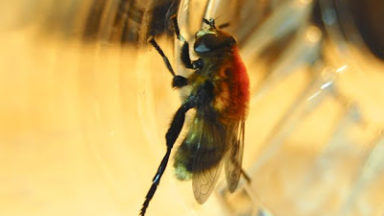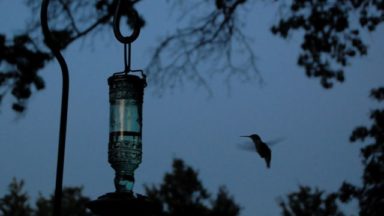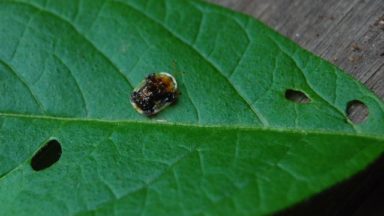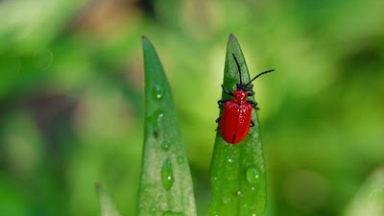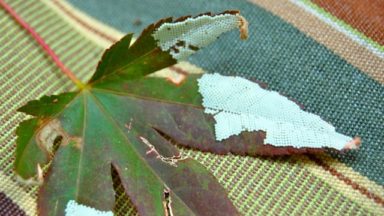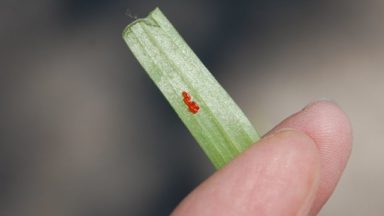A screw-up with iPhoto deleted my 2013 “Scott Shot” of urban bee guru Scott MacIvor, so I’ll have to make do with 2012. With some regret, last month I waved bye-bye to my last urban wild bee nesting box – or, the last in the three-year study by ecologist and PhD candidate Scott MacIvor. Read […]
About those green dots on Toronto’s ash trees
Green dots goooood; orange dots, baaaaad. What the heck are those online pharmacy buy vilitra with best prices today in the USA green dots? I wondered, as I walked up Coxwell Avenue the other day. They were painted on most of the towering ash trees (Fraxinus spp.) that line this stretch of road. Oh no. […]
An unexpected home visit from a bee mimic
This hoverfly might be narcissus bulb fly. Boo hoo. It sure looked like some kind of red-headed bee to me when I found it s buy zocor online www.delineation.ca/wp-content/uploads/2024/08/jpg/zocor.html no prescription pharmacy itting on a Pelargonium leaf in my west-facing window. Out came a drinking glass and piece of card to capture it while I […]
Recycle an old hose into a bee hotel
A great idea for a DIY bee hotel, from St Fagans National History Museum in Wales Remember that hose the car ran over – and sprang a leak? It could have online pharmacy bu online pharmacy buy deltasone with best prices today in the USA y symbicort inhaler with best prices today in the USA […]
Close encounters of the hummingbird kind
A pre-dawn hummer goes for the nectar at the Indianapolis Museum of Art Long, thoughtful posts, full of depth and perspective, aren’t always possible at the best of times. They’re even harder when you’re trying to post every day for thirty days as a sort of shadow NaBloPoMo (National Blog Posting Month – a poor […]
Meet the Clavate tortoise beetle
Clavate tortoise beetle on a chewed potato leaf. Note that teddybear shape on its back. Noticing some pellet holes in my potato leaves, I wondered if we’d been hit by flea beetles. Then I saw what looked like a small fleck of bird droppings on the leaf. When flicked, it moved. That’s when I first […]
Lily leaf beetle season
Get those squishing fingers on. The lily leaf beetles are back, and they’re noshing on your Asiatic and Oriental lilies. In fact, they’re making like the two-backed beast, or beetle, to create the next generations of bright red eating machines. Until they earn their red beetle wings, these will be squishy brown blobs of beetle […]
Bee, my love, for Earth Day 2011
Study nesting box for wild solitary bees Something special arrived in our back yard on Earth Day 2011: a nesting box for wild cavity-nesting solitary bees such as mason (Osmia) and leaf-cutter bees (Megachile). It’s one of 220 scat online pharmacy buy hydroxychloroquine with best prices today in the USA tered in private and […]
Nip this bug problem in the bud… or in the egg
During a post-vacation check-up of my heat-challenged, newly planted Japanese mapl buy advair online youngchiropractic.com.au/wp-content/uploads/2024/08/jpg/advair.html no prescription pharmacy e this morning I spied this pixel-patterned egg mass. Aha! I exclaimed, summoning my vast store of entomological knowledge, Those are definitely the eggs of some kind of insect. No, I’m not an entomologist. But I can […]
Red Alert: Lily Leaf Beetle Eggs
Nip your lily leaf beetle problem in the bud, or in the egg, by squishing this pest’s red, shiny ova before they hatch. Here’s what they look like… laid in a line, on the underside of lily leaves. Oriental and Asiatic lilies are particularly yummy to the lily leaf beetle, and the three successive generations […]
Red Admiral Butterfly
I’ve online pharmacy buy cymbalta with best prices today in the USA been sufferi online pharmacy buy addyi with best prices today in the USA ng a major case of butterfly envy. My neighbour M. has been luring the Monarch butterflies (Danaus plexippus) over to his mature purple butterfly bush (Buddleia) for some time. This […]
Who knows what lily beetles lurk…
So-called-summer 2009 has been the summer of love for lily leaf beetles. Since I wrote about them on June 1st, they’ve been arriving by the thousands, camping out and making music. And they’re hungry. Turn your back for an instant and you’re growing poles, not lilies. The whole stem is defoliated, leaving the bulb nothing […]



